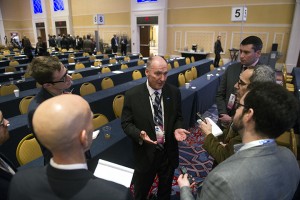
By Ralph Russo
Associated Press
OXON HILL, Md. — Two huge video screens flanked a banner that stretched about the length of a third-and-long and hung behind the dais at the front of an expansive ballroom.
On the banner and the screens were the logos of the five wealthiest and most powerful conferences in college athletics: the Atlantic Coast Conference, Big Ten, Big 12, Pac-12 and Southeastern Conference.
The future of the NCAA, big-time college sports and the definition of the term student-athlete is now in their hands.
Their first order of business came Saturday when the so-called Big Five used its newly granted autonomy to pass NCAA legislation that increases the value of an athletic scholarship by several thousand dollars to cover the federally determined actual cost of attendance.
It’s not pay for play, but athletes will now get a bigger cut of the billions of dollars generated by college sports.
“You can’t miss the significance of the day,” SEC Executive Associate Commissioner Greg Sankey said. “The five conferences showed the ability to use this opportunity in a meaningful and positive way.”
Legislative autonomy for the Big Five was voted in last year and this year’s NCAA convention was its first chance to use it.
The group of 65 schools can pass legislation on its own, without the support of the schools in the other 27 Division I conferences.
“It’s historic, first of all, in that these 65 schools are in a room by themselves with the ability to pass legislation. That’s never happened before,” ACC Commissioner John Swofford said. “I’ve never attended a convention where the primary focus of most of what was being discussed was about the student-athlete and the student-athletes’ experiences.”
And for the first time in NCAA Division I history student-athletes were involved in the voting process, making up 15 of the 80 total delegates. They provided some of the most spirited debate during the discussion forum when a proposal to guarantee four-year scholarships that cannot be revoked because of athletic performance was introduced. That proposal passed, but five athletes voted against it.
“We literally walked in here with a vote that was equal to the president of the school, that was equal to the compliance director, that was equal to the guy with 17 degrees,” Oklahoma football player Ty Darlington said. “That may seem ludicrous to some people but I think it’s important because we’re the ones that are going through the experience.”
The new structure requires approval from three of the five conferences and 60 percent of the schools to pass legislation. A proposal can also be passed with a simple majority of schools if four of the five conferences approve.
The cost of attendance proposal passed with overwhelming support, by a 79-1 margin, drawing a smattering of anticlimactic applause from the delegates. It will go into effect Aug. 1.
By the same margin, the schools also passed a resolution to “modernize the collegiate model.” The only school to vote against both measures was Boston College.
“I never assumed that it was just, check a box,” said Sankey, who has been one of the leading architects of the new NCAA governance structure. “When I woke up this morning I said, ‘I wonder what’s going to happen?’”
Also passed was a proposal that requires all schools have a written concussion protocol approved by a concussion safety protocol committee.
The move toward autonomy began after a proposal to add a $2,000 stipend to the value of a scholarship to help cover the cost of attendance for athletes was shot down in 2011 by schools concerned they could not afford it and it would create a recruiting advantage for those that could.
Now those schools can’t stand in the way on certain issues, though the legislation passed Saturday allows any school to opt in — or out.
The exact value of cost of attendance will vary from school to school. Currently, an athletic scholarship covers the cost of tuition, room and board, books and fees. The new scholarships will cover the cost of additional expenses, up to the full amount a traditional student might spend annually.
Some outside the Big Five fear the cost of attendance increase is a step in the wrong direction for college athletics.
Monmouth University President Paul Brown called it “a slippery slope that is not only wrong, but also financially unsustainable for many institutions, including my own,” in a recent editorial for NJ.com and The Star-Ledger.
Those in the room Saturday pledged to keep Division I together and think beyond their own best interests, but they are clearly shaping the future of college sports


